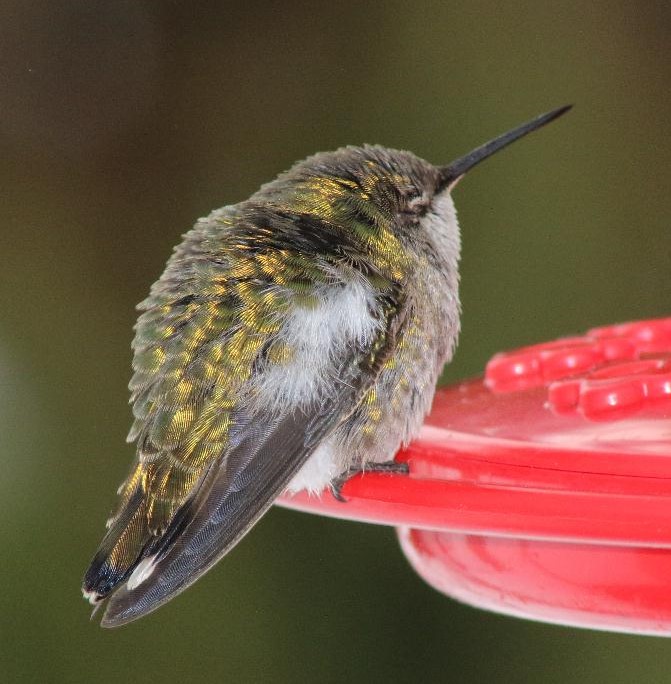In December, 2015, Julie Edmonds had a female hummingbird at her feeder that looked different than her occasional Anna’s. Julie lives near Drew, south of Tiller, in the foothills of the SE Douglas County Cascades, at just over 1500 ft elevation. She happened to mention this hummingbird on the Umpqua Birds email list, and the fact that the bird had died. Knowing that Julie photographs most of the birds she sees, I asked her if she had photos. The photo below is the best of those she sent to me.
 |
| Photo by Julie Edmonds, December 2015 |
I was intrigued by the photo. It appeared to be a Calypte hummingbird (Calypte is the genus of Anna’s and Costa’s hummingbirds) based on the shape of the primaries, grayish vs buffy sides, and lack of rufous in the tail, but the bird showed some features of Costa’s rather than the expected Anna’s Hummingbird. The Costa’s features include a very plain-looking throat, tail shorter than wingtips, and what appears to be a very narrow r5 (the outermost tail feather). However, at this angle, and with the bird all puffed up, could I be sure of any of these features?
Fortunately for us, Julie had put the deceased hummingbird in her freezer, so we had opportunity for further examination. Also fortunately for us, we have an experienced and licensed bird bander in our area, Liz Gayner, wildlife biologist with the Roseburg BLM. Liz agreed to help us take numerous measurements of the bird that would hopefully allow us to determine the species with more confidence.
We used information from Table 2 in Peter Pyle’s banding book (1997, Identification Guide to North American Birds, Part I), as a reference with which to compare our measurements of the bird. In the table below, I list our measurements of the BIRD, and the ranges given in Pyle (1997) for female and immature Anna’s and Costa’s Hummingbirds in North America (ranges are mean +/- 2 standard deviations). Note: HY, SY, etc. are banding term abbreviations regarding the age of the bird, to learn more click here. I put a gray background behind the ranges within which our measurements fell.
| MEASUREMENT(mm) | BIRD | ANNA’S | COSTA’S | ||
| Wing chord | 48 | 46.2-51.5 | 42.3-46.5 | ||
| female | 46.4-51.5 | 42.9-46.5 | |||
| male | 46.2-51.3 | 42.3-45.7 | |||
| Tail length | 28 | 24.9-30.1 | 20.9-25.3 | ||
| female | 24.9-29.3 | 21.3-25.3 | |||
| juv-HY/SY male | 25.2-30.1 | 20.9-24.2 | |||
| (AHY/ASY male) | (29.1-33.9) | (21.0-24.7) | |||
| Exposed culmen | 16.4 | 16.1-20.6 | 15.5-18.8 | ||
| female | 15.4-19.6 | 16.3-18.8 | |||
| male | 15.3-19.5 | 15.5-18.1 | |||
| Tail fork | 2.2 | 0 to 4 | -4 to 1 | ||
| female | 0 to 2 | -4 to -2 | |||
| juv-HY/SY male | 2 to 4 | -2 to 1 | |||
| Width of r5 | 5.1+ | 5.0-6.3 | 2.8-4.2 | ||
| Juv-HY/SY female | 5.3-6.3 | 3.2-4.2 | |||
| AHY/ASY female | 5.0-6.0 | 3.1-4.1 | |||
| Juv-HY/SY male | 5.2-6.2 | 2.8-3.8 | |||
| Outer primary shape | C | A-C | A-C | ||
| Juv-HY/SY female | C | C | |||
| AHY/ASY female | B | B | |||
| Juv-HY/SY male | A-C | A-C | |||
| Flank color | Whitish Gray | green & gray | whitish buffy |
Liz first looked at the bill to see if she could see corrugations or other texture that would suggest the bird was young. It was a difficult call, especially on a frozen and thawed dead bird, but she thought she could see some texture that looked like the bill of a young hummingbird. She also thought the buffy tips of many of the body feathers indicated a young bird.
As you can see in the table, all measurements fit within the range of Anna’s Hummingbird. Wing chord, tail length, tail fork, and width of r5 fall outside of the range given for Costa’s Hummingbird; exposed culmen is somewhat on the short side(possibly suggesting a very young bird) and fits in ranges given for either species. I added a plus sign (+) to our measurements of the r5 width, because as I watched Liz measure these tiny feathers with her somewhat stiff calipers, I could see that it was very difficult to be sure one was just touching the edge of the feather without compressing it at all.
| Bill showing remnants of bill corrugations (little wringles near lateral grooves). |
The throat, even in life, was fairly plain, with just dull spots on pale throat feathers.
| Throat feathers with dull gray centers (not visible in live photo from side) and broad pale edges. |
| Outer tail feather (r5) within range for Anna’s Hummingbird. Pattern of indented black indicates female. |
Conclusion: All measurements strongly support Anna’s Hummingbird, likely a young female. The fairly pale throat and sides seem due to the quite fresh plumage (broad pale edges) on a young female. The tail measurement was not unusually short, so the wings clearly past the tail in the live photo could be due to the poor condition of the bird which may have allowed the wings to droop. These are just possibilities; we really don’t know.
If you have any helpful thoughts or input, please leave us a comment.
